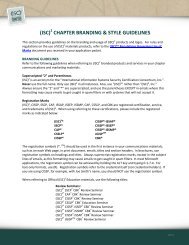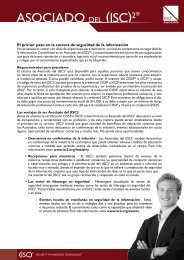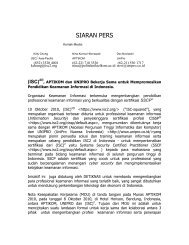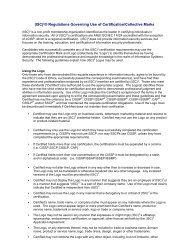Code (In)Security - ISC
Code (In)Security - ISC
Code (In)Security - ISC
You also want an ePaper? Increase the reach of your titles
YUMPU automatically turns print PDFs into web optimized ePapers that Google loves.
<strong>In</strong>troduction<br />
Past (<strong>ISC</strong>) 2® published whitepapers have discussed the basics<br />
of software security as it pertains to various stakeholders. <strong>In</strong><br />
response to reader requests, this whitepaper will look at software<br />
security from the perspective of a software developer.<br />
<strong>In</strong> the book, Hacking: the Art of Exploitation a , author Jon Erickson<br />
accurately and succinctly expresses that an understanding of<br />
writing code helps those who exploit it, and an understanding of<br />
exploitation helps those who write code. A software developer,<br />
in other words, must first know how their code can be exploited<br />
(insecure code) and then, in turn, use that knowledge to write<br />
code that is not exploitable (code in security). Just as when<br />
attempting to cure a malady, a physician needs to first diagnose<br />
the core issue before treating the symptoms, when developing<br />
hack-resilient software, one must first understand what constitutes<br />
insecure code, before attempting to address vulnerabilities.<br />
<strong>In</strong>troducing <strong>Code</strong> (<strong>In</strong>)<strong>Security</strong><br />
It must be stated from the outset, however, that software security<br />
is more than writing secure code. <strong>In</strong> today’s security landscape,<br />
considerations must go beyond mere functionality to take into<br />
account security as well. There are several noteworthy resources<br />
on software security; some of those worth mentioning are<br />
the Hacking Exposed series, 19 Deadly Sins of Software <strong>Security</strong>,<br />
Exploiting Software, Building Secure Software, and Writing Secure<br />
<strong>Code</strong>. But even though these resources are considered mustreads<br />
for any software developer, evidence from sources such<br />
as the Chronology of Data Breaches b and security bug- and full<br />
disclosure-lists show that software applications produced today<br />
are still rife with vulnerabilities. <strong>Security</strong> breaches are merely<br />
the symptoms of insecure design and programming, and unless<br />
software developers are trained to architect secure software and<br />
identify what constitutes insecure code, the trend of software<br />
rampant with security weaknesses is likely to continue.<br />
1<br />
There is a lingering debate about who is ultimately responsible for<br />
software insecurity. Opinions vary. Is it the software publishers, or the<br />
organization as a whole? Some feel that the blame should rest with<br />
the coder. But without proper education being imparted to software<br />
coders as to how to write ‘secure’ code or how to not write<br />
‘insecure’ code, it is unreasonable to put the blame totally on them.<br />
It is the opinion of this author that software insecurity must be<br />
attributable to all stakeholders in the software development<br />
lifecycle, and software developers, who write code, can play a<br />
vital role in the development of secure software.<br />
INSECURE <strong>Code</strong><br />
<strong>Code</strong> (<strong>In</strong>)<strong>Security</strong><br />
Mano Paul, CSSLP, CISSP, AMBCI, MCAD, MCSD, Network+, ECSA<br />
“Software insecurity must be attributable<br />
to all stakeholders in the software<br />
development lifecycle, and software developers,<br />
who write code, can play a vital role in the<br />
development of secure software.”<br />
As the Chinese adage goes, a journey of a thousand miles begins<br />
with a single step. The journey to develop secure software begins<br />
with the first step of identifying what makes up insecure code.<br />
So what is insecure code? <strong>In</strong>secure code is code which is<br />
vulnerable to security attacks. For the benefit of the reader, the<br />
word “insecure” itself may be used as an acrostic, to describe<br />
programming constructs and code that are vulnerable to security<br />
breaches. The following is by no means an all-inclusive list of<br />
everything that constitutes insecure code, but is a compilation<br />
of the most prevalent programming constructs that have been<br />
observed to render software insecure.<br />
www.isc2.org
Characteristics of <strong>In</strong>secure <strong>Code</strong><br />
Characteristic<br />
I<br />
N<br />
S<br />
E<br />
C<br />
U<br />
R<br />
E<br />
<strong>In</strong>jectable <strong>Code</strong><br />
Non-Repudiation Mechanisms not Present<br />
Spoofable <strong>Code</strong><br />
Exceptions and Errors not Properly Handled<br />
Cryptographically Weak <strong>Code</strong><br />
Unsafe/Unused Functions and Routines in <strong>Code</strong><br />
Reversible <strong>Code</strong><br />
Elevated Privileges Required to Run<br />
I - <strong>In</strong>jectable <strong>Code</strong><br />
<strong>In</strong>jectable code is code that makes the infamous and prevalent<br />
injection attacks possible, allowing the user-supplied data to be<br />
executed as code. There are various types of injection attacks:<br />
attacks against databases (e.g., SQL injection), attacks against<br />
directory structures (e.g., LDAP injection), and even attacks against<br />
the operating system itself (e.g., OS command injection). Improper<br />
validation or filtration leads to injectable code attacks.<br />
Lack of validation of user-supplied input is the primary reason why<br />
injection attacks are possible, resulting in serious consequences.<br />
Breaches such as the disclosure of sensitive information<br />
(confidentiality breach), tampering and manipulation of directory<br />
structures and trees (integrity breach), denial of service (availability<br />
breach), authentication and authorization check bypass, and even<br />
remote code execution are possible.<br />
Coding constructs that depend on the user-supplied data to<br />
build the queries to be executed in the backend on-the-fly<br />
(dynamically) is another possibility that should not be overlooked.<br />
There are many defensive coding techniques against injectable<br />
code. One option is input sanitization, which can be achieved<br />
either by allowing only a certain set of valid inputs, or disallowing<br />
and removing any invalid input patterns and characters.<br />
A second option is the use of parameterized queries, those that<br />
are not dynamically generated. These take the user-supplied input<br />
as parameters. When architected correctly, they also aid with<br />
performance. Coding standards should disallow the dynamic<br />
construction of queries in code to mitgate injection attacks and<br />
this must be enforced.<br />
2<br />
“All <strong>In</strong>put Data is Evil-So Make Sure You Handle It Correctly and<br />
with Due Care” c by Dino Esposito, published in CoDe magazine is<br />
a good reference article and as the latter half of the title rightfully<br />
suggests, it is extremely important to be able to identify injectable<br />
code and take necessary steps (due care) to address it.<br />
N - Non-Repudiation Mechanisms not Present<br />
<strong>In</strong> a highly interconnected and mobile world, it is imperative<br />
that the authenticity of code origin, and critical business and<br />
administrative transactions be indisputable. Non-repudiation is<br />
the guarantee that the origin of code is what it claims to be. It<br />
is the ability to verify the authenticity of the code’s origin. This is<br />
particularly important because code can be downloaded from<br />
a remote location and executed on a local system. Referred<br />
to as “mobile” code, it must carry proof of its origin to verify<br />
authenticity, which can be achieved by signing the code. <strong>Code</strong><br />
signing is the process of digitally signing code (executables, scripts<br />
etc.), to assure that the code has not been tampered with, and<br />
that the code is from a valid software publisher. <strong>Code</strong> signing is<br />
also known as digital shrink-wrapping.<br />
Non-repudiation also applies to ensuring that the actions taken<br />
by the code cannot be denied.<br />
Auditing functionality in code is a mechanism to ensure that<br />
repudiation is not possible. At a bare minimum, for critical business<br />
and administrative transactions, the code must be written to record<br />
the action taken, including the timestamp and other pertinent<br />
details such as the user or process that is performing the action.<br />
S – Spoofable <strong>Code</strong><br />
Spoofing is the act of impersonating another user or process.<br />
Spoofable code is code that allows for spoofing attacks. Spoofing<br />
attacks allow the impersonator to perform actions with the<br />
same level of trust as a valid user, who has been impersonated.<br />
Disclosure of information to unintended users, tampering with<br />
data, resource exhaustion, bypassing authentication, circumventing<br />
authorization checks, deletion or manipulation of audit logs are all<br />
potential consequences of spoofing.<br />
Spoofing has been observed in cases where the code base is not<br />
segmented to run under different execution contexts based on<br />
the trust (privilege) levels of the caller of the code. This violates<br />
the principle of “least common mechanism” which states that<br />
mechanisms common to more than one user/process are not<br />
shared d . With just one execution context for all code, an attacker<br />
can spoof an identity and execute the code as if the attacker was<br />
a valid user with permission.<br />
www.isc2.org
Predictable session identifiers, hard-coded passwords, caching<br />
credentials, and allowing identity impersonation are common<br />
coding vulnerabilities that can result in spoofing attacks. Figure 1 is<br />
an example of a configuration entry that allows impersonation of<br />
a specific user. <strong>In</strong> addition to the fact that impersonation is allowed,<br />
the username and password is hard-coded inline in plain text, which<br />
is also not recommended. Figure 2 is an example that illustrates<br />
how an authenticated user’s identity is impersonated in code.<br />
Spoofable code can lead to several security compromises, the<br />
most common of which is session hijacking and replay attacks.<br />
An attacker can impersonate the identity of a valid user and take<br />
control over an established session between the client and the<br />
server and then replay the action.<br />
<strong>In</strong> the event that there may be a valid business reason to allow<br />
for impersonation, such actions must be closely monitored and<br />
audited. Care must be taken to ensure that code written does not<br />
allow for impersonation and spoofing attacks.<br />
E – Exceptions and Errors not Properly Handled<br />
Any software developer understands that it is very hard to<br />
make software code error free. Exceptions and errors are<br />
inevitable. However, not handling exceptions and errors, or<br />
handling them improperly, are unacceptable options when it<br />
comes to software security.<br />
Figure 1. Configuration setting to impersonate a specific user<br />
Figure 2. Impersonating the authenticated user in code<br />
Figure 3. Error message discloses account name exception details<br />
3<br />
<strong>Code</strong> that reveals verbose details is an example of improper<br />
handling of exceptions and errors.<br />
A simple example of a verbose error is “Username is invalid” during<br />
an authentication attempt. Even a simple message such as this is<br />
more information than necessary. A message such as “Login invalid”<br />
is sufficient. This non-verbose error message now leaves the attacker<br />
to guess whether it is the username or the password which is<br />
invalid, unlike in the previous case where the attacker knows that it<br />
is the username which is invalid. Non-verbose error messages and<br />
not displaying raw exception details will considerably increase the<br />
work factor for the attacker who is trying to break into your system.<br />
This can, however, have a negative impact on troubleshooting and<br />
customer support, and so design considerations should be factored<br />
in so that the software will display the appropriate verbosity of<br />
error messages, without revealing the details.<br />
Improper handling of exceptions and error details can lead to<br />
disclosure of internal architecture, data flows, data types, data<br />
values, and code paths. During a reconnaissance exercise, an<br />
attacker can use the information gleaned from a verbose error<br />
message, or in the exception details, to profile the software.<br />
Figure 3 illustrates how an unhandled exception discloses that<br />
there is a login account name SecuRiskLabUser, besides revealing<br />
the exception details stack trace which can provide an attacker<br />
information that they can use to profile the software.<br />
www.isc2.org
The absence of a catch-all exception-handling routine, and merely<br />
bubbling the raw exception information to the front end or client, is<br />
another example of improper exception or error handling. When an<br />
exception is caught, the code must handle the exception explicitly.<br />
Additionally, in the event of failure, assets should not be put at risk,<br />
which is the principle of fail-safe or fail-secure. Decisions must be<br />
based on explicit permissions instead of exclusions.<br />
It is important to ensure that errors and exceptions are handled so<br />
that they are non-verbose, do not reveal more information than is<br />
necessary, and do not violate the principles of fail-safe or fail-secure.<br />
C – Cryptographically Weak <strong>Code</strong><br />
Developers are essentially creative problem solvers who use<br />
their skills and technological know-how to create solutions to<br />
solve business problems and needs. Developers seek to improve<br />
existing functionality. Unfortunately, this has been known to<br />
backfire, especially in the context of cryptography, as evidenced by<br />
the various poor custom cryptography implementations observed<br />
in code reviews.<br />
Such reviews reveal that cryptographic functionality in code is,<br />
more often than not, custom-developed, rather than developed<br />
by leveraging existing proven and validated standard cryptographic<br />
algorithms. This contradicts the secure design principle of<br />
“leveraging existing components” to minimize the attack surface.<br />
Additionally even when proven cryptographic algorithms are<br />
used, implementation detail have been found to be insecure.<br />
Cryptography algorithms use a secret value, known as a key,<br />
to encrypt (convert plain text to cipher text) and decrypt<br />
(convert cipher text to plain text). The key to the strength of a<br />
cryptographic implementation is not necessarily the strength of<br />
the algorithm itself, but the way the key is derived and managed.<br />
Using non-random numbers to derive the cryptographic keys<br />
renders the cryptographic protection weak and ineffective.<br />
Sometimes ASCII passwords that are easily guessable and nonrandom<br />
are used to derive the cryptographic key, which should<br />
be avoided. Another common problem is that keys are not stored<br />
in a secure manner. Keys have been observed to be hard-coded<br />
inline with the code. This is akin to locking your doors and leaving<br />
the keys in the lock, thus providing minimal protection if any<br />
protection at all.<br />
Special attention must be paid when choosing the algorithm<br />
to see what the exploitability of the algorithm has been. Once<br />
chosen, Random Number Generators (RNG) and Pseudo-<br />
Random Number Generators (PRNG) must be used to derive<br />
the cryptography key for encryption and decryption. Derived keys<br />
must also be stored in a secure manner.<br />
4<br />
U – Unsafe/Unused Functions and Routines in <strong>Code</strong><br />
Unsafe functions are those that have been found to be inherently<br />
dangerous. These functions were developed without necessarily<br />
taking into account the security implications. The use of these<br />
functions gives the programmer no assurance of security<br />
protection. They can result in vulnerabilities that could allow an<br />
attacker to corrupt the system’s memory and/or gain complete<br />
control over a system. One of the reasons attributable to the<br />
infamous buffer overrun attack is the use of unsafe functions in<br />
code. Several security bulletins and patches have been published<br />
to address these functions.<br />
Unsafe functions are predominantly seen in legacy and older<br />
generation programming languages. Two common examples of<br />
these functions in the C programming language are strcpy and<br />
strcat. Since these functions do not perform length/size checks<br />
(also known as bounds checking), an attacker can supply inputs<br />
of arbitrary sizes that can overflow memory buffers. Figure 4 is<br />
an example of the unsafe C function strcpy being used to copy<br />
the input data into a local memory buffer. If there is no bounds<br />
checking, and the user-supplied input has more characters than<br />
the local memory buffer can hold, the result will be an overflow<br />
of the local memory buffer.<br />
Figure 4. Use of unsafe ‘strcpy’ C function<br />
Today, software publishers of programming languages are avoiding<br />
unsafe functions in favor of safer alternatives such as the strncpy and<br />
strncat, which allow the developer to perform length/size checks.<br />
Another insecure coding construct, observed in code reviews,<br />
is the presence of unused functions where redundant code that<br />
no longer addresses any business functionality is left remaining.<br />
Changes in the business and advancements in technology and<br />
the apprehension of breaking backward compatibility are reasons<br />
unused functions might be left in the code. This increases the<br />
relative attack surface of the code.<br />
Another classic example of unused functions in code is something<br />
known as “Easter eggs”. An Easter egg in software is secretly<br />
hidden code that can result in a change of program behavior<br />
(e.g., displaying a message, playing a sound, etc.) when particular<br />
conditions (e.g., a series of mouse clicks, keystrokes, etc.) are<br />
met. Easter eggs are usually innocuous, but they also increase the<br />
attack surface of the code and hence can have potentially serious<br />
security consequences. Risk of losing customers, introducing newer<br />
bugs, and performance impacts leading to resource exhaustions,<br />
i.e., availability impact, (along with the risk of looking like an<br />
www.isc2.org
eggomaniac!) are some of the detrimental effects of Easter eggs.<br />
IT World’s article “Favorite software Easter Eggs” e is an interesting<br />
article that highlights the sinister side of Easter eggs in software.<br />
It is a best practice to minimize the relative attack surface of the<br />
code, and this means avoiding the use of unsafe functions, removing<br />
unused functions that cannot be traced to a requirements<br />
traceability matrix, and avoiding coding in Easter eggs.<br />
R – Reversible <strong>Code</strong><br />
The acclaimed IEEE paper entitled “Reverse Engineering and<br />
Design Recovery: A Taxonomy”, defines reverse engineering<br />
as “the process of analyzing a subject system to identify the<br />
system’s components and their interrelationships and create<br />
representations of the system in another form or at a higher level<br />
of abstraction.” f <strong>In</strong> simpler terms, software reverse engineering,<br />
or reversing, is the process of going backwards from system or<br />
code to determine the internal design and implementation details.<br />
Reversing can be performed on software at the system level or<br />
at the code level.<br />
Un-obfuscated or unsigned code is easily reversible. Obfuscation<br />
of code is the process of making the code functionality difficult<br />
to understand, and is sometimes referred to as “shrouded” code.<br />
Obfuscation is convoluting the code so much that even if you<br />
have its source, it cannot be understood. Programs known as<br />
obfuscators operate on source code, object code, or both, mainly<br />
for the purpose of deterring reverse engineering. Figure 5 depicts<br />
an un-obfuscated and an obfuscated version of a simple print<br />
HelloWorld program g . Signing code (discussed earlier) is another<br />
Figure 5. HelloWorld program before and after code obfuscation<br />
Before<br />
5<br />
anti-reversing technique, which offers more protection than<br />
obfuscation. Checking for the presence of debuggers in code and<br />
tricking de-compilers using non-instruction data or junk bytes h are<br />
other anti-reversing techniques.<br />
It must be recognized that all of these anti-reversing techniques<br />
can only deter reversing, not necessarily prevent it. But it is<br />
imperative that code be protected as much as is possible from the<br />
risks of reversing. Eldad Eilam’s book, Reversing - Secrets of Reverse<br />
Engineering, is an excellent resource and a must-read for anyone<br />
interested in writing irreversible code.<br />
E – Elevated Privileges Required to Run<br />
The principle of least privilege states that a user or process<br />
is given explicitly only the necessary, minimum level of access<br />
rights (privileges) for the minimum amount of time required to<br />
complete the user’s or process’s operation. Sometimes, however,<br />
code that runs in a less secure development environment<br />
experiences hiccups or fails to run when deployed into a more<br />
restrictive production environment. The usual solutions in such<br />
cases are to increase the privilege level under which the code<br />
can execute, or remove the checks for privilege levels. Neither<br />
of these “solutions” is recommended from a security standpoint.<br />
They could lead to circumventing permissions, allowing users and<br />
processes with lower privilege to execute code that they are not<br />
authorized to.<br />
An additional example is code that can be explicitly set to run<br />
with elevated (administrative) privileges programmatically, another<br />
classic indicator of insecure code.<br />
After<br />
www.isc2.org
Configuration differences between the development and<br />
production environments must be ensured so that code can<br />
execute with least privilege, irrespective of the environment. It<br />
is also imperative to ensure that code explicitly set to run with<br />
elevated privileges is carefully monitored (audited) and managed.<br />
Conclusion<br />
‘Don’t write insecure code’ is one of the eight secure habits discussed<br />
in “8 Simple Rules for Developing More Secure <strong>Code</strong>”. i Without a<br />
thorough understanding of what constitutes insecure code, it would<br />
be unfair to expect developers to write more secure code.<br />
“It is critical to all those who write<br />
code to make it a habit to incorporate<br />
security in the code they write. ”<br />
Should your code fall victim to a security breach, the code itself<br />
would be deemed innocent, but that kind of leniency will not be<br />
extended to the individual, team, or organization that wrote the<br />
code. So it is critical to all those who write code to make it a habit<br />
to incorporate security in the code they write.<br />
• Validates input<br />
Secure <strong>Code</strong> Characteristics<br />
• Does not allow dynamic construction of queries using<br />
user-supplied data<br />
• Audits and logs business-critical functions<br />
• Is signed to verify the authenticity of its origin<br />
• Does not use predictable session identifiers<br />
• Does not hard-code secrets inline<br />
• Does not cache credentials<br />
• Is properly instrumented<br />
• Handles exceptions explicitly<br />
• Does not disclose too much information in its errors<br />
• Does not reinvent existing functionality, and uses proven<br />
cryptographic algorithms<br />
• Does not use weak cryptographic algorithms<br />
• Uses randomness in the derivation of cryptographic keys<br />
• Stores cryptographic keys securely<br />
• Does not use banned APIs and unsafe functions<br />
• Is obfuscated or shrouded<br />
• Is built to run with least privilege<br />
6<br />
“Writing secure code has the added benefit<br />
of producing code that is of quality –<br />
functional, reliable, and less error-prone.”<br />
It would be far beyond the scope of this paper to enumerate all the<br />
ways that one can avoid writing insecure code, and/or write secure<br />
code. <strong>In</strong>stead, this should be treated as merely an eye-opener to<br />
how to code securely, and the tremendous risks of not doing so.<br />
Just as a game of chess produces an infinite number of moves<br />
once the game begins, with a limited number of opening gambits,<br />
understanding the characteristics of insecure code is one of the<br />
first moves to ensure that code is written to be hacker-resistant.<br />
<strong>In</strong>secure code means checkmate.<br />
www.isc2.org
Summary of <strong>In</strong>secure Concepts<br />
I<br />
N<br />
S<br />
E<br />
C<br />
U<br />
R<br />
E<br />
Characteristic<br />
<strong>In</strong>jectable <strong>Code</strong><br />
Non-Repudiation<br />
Mechanisms not Present<br />
Spoofable <strong>Code</strong><br />
Exceptions and Errors<br />
not Properly Handled<br />
Cryptographically Weak<br />
<strong>Code</strong><br />
Unsafe/Unused<br />
Functions and<br />
Routines in <strong>Code</strong><br />
Reversible <strong>Code</strong><br />
Elevated Privileges<br />
Required to Run<br />
What is it?<br />
<strong>Code</strong> that makes<br />
injection attacks<br />
possible by allowing user<br />
supplied input to be<br />
executed as code.<br />
Authenticity of code<br />
origin and actions are<br />
disputable.<br />
<strong>Code</strong> that making<br />
spoofing attacks<br />
possible.<br />
<strong>Code</strong> that reveals<br />
verbose error messages<br />
and exception details, or<br />
fails-open in the event of<br />
a failure.<br />
<strong>Code</strong> that uses nonstandard,<br />
weak or<br />
custom cryptographic<br />
algorithms and manages<br />
key insecurely.<br />
<strong>Code</strong> that increases<br />
attack surface by<br />
using unsafe routines<br />
or containing unused<br />
routines.<br />
<strong>Code</strong> that allows for<br />
determination of<br />
internal architecture,<br />
design.<br />
<strong>Code</strong> that violates<br />
the principle of least<br />
privilege.<br />
7<br />
<strong>In</strong>secure <strong>Code</strong><br />
Examples<br />
No input validation,<br />
Dynamic construction<br />
of queries<br />
Unsigned executables,<br />
Auditing not present<br />
Predictable session<br />
identifiers, hard-coded<br />
passwords, caching<br />
credentials and allowing<br />
identity impersonation<br />
Verbose errors,<br />
Unhandled exceptions,<br />
Fails open<br />
Key not derived and<br />
managed securely<br />
Banned API functions,<br />
Easter Eggs<br />
Unobfuscated code,<br />
Unsigned Executables<br />
Administrative accounts<br />
How to Fix It<br />
<strong>In</strong>put Validation,<br />
Parameterized queries<br />
<strong>Code</strong> Signing<br />
Session, Cache and<br />
Password Management,<br />
Managing identity<br />
impersonation<br />
Non-verbose error<br />
messages, Explicit<br />
exception handing (Try-<br />
Catch-Finally) blocks,<br />
Fail-secure<br />
Do not use weak, nonstandard<br />
algorithms,<br />
custom cryptography,<br />
Use RNG and PRNG for<br />
key derivation.<br />
Do not use banned<br />
APIs unsafe functions,<br />
<strong>In</strong>put validation, remove<br />
unused routines and<br />
Easter eggs.<br />
<strong>Code</strong> obfuscation<br />
(shrouding), Digitally<br />
signing code<br />
Environment<br />
configuration, <strong>Code</strong> set<br />
explicitly to run with<br />
least privilege<br />
www.isc2.org
About (<strong>ISC</strong>)² ®<br />
The <strong>In</strong>ternational <strong>In</strong>formation Systems <strong>Security</strong> Certification<br />
Consortium, <strong>In</strong>c. [(<strong>ISC</strong>) 2® ] is the globally recognized Gold Standard<br />
for certifying information security professionals. Founded in<br />
1989, (<strong>ISC</strong>)² has now certified over 60,000 information security<br />
professionals in more than 130 countries. Based in Palm Harbor,<br />
Florida, USA, with offices in Washington, D.C., London, Hong<br />
Kong and Tokyo, (<strong>ISC</strong>) 2 issues the Certified <strong>In</strong>formation Systems<br />
<strong>Security</strong> Professional (CISSP ® ) and related concentrations,<br />
Certified Secure Software Lifecycle Professional (CSSLP CM ),<br />
Certification and Accreditation Professional (CAP ® ), and Systems<br />
<strong>Security</strong> Certified Practitioner (SSCP ® ) credentials to those<br />
meeting necessary competency requirements. (<strong>ISC</strong>)² CISSP and<br />
related concentrations, CAP, and the SSCP certifications are<br />
among the first information technology credentials to meet the<br />
stringent requirements of ANSI/ISO/IEC Standard 17024, a global<br />
benchmark for assessing and certifying personnel. (<strong>ISC</strong>)² also<br />
offers a continuing professional education program, a portfolio<br />
of education products and services based upon (<strong>ISC</strong>) 2 ’s CBK ® , a<br />
compendium of information security topics, and is responsible for<br />
the (<strong>ISC</strong>)² Global <strong>In</strong>formation <strong>Security</strong> Workforce Study. More<br />
information is available at www.isc2.org.<br />
8<br />
About the Author<br />
Mano Paul, CSSLP, CISSP, AMBCI, MCAD, MCSD, Network+,<br />
ECSA is CEO and President of Express Certifications and<br />
SecuRisk Solutions, companies specializing in professional training,<br />
certification, security products and security consulting. His security<br />
experience includes designing and developing software security<br />
programs from Compliance-to-Coding, application security risk<br />
management, security strategy and management, and conducting<br />
security awareness sessions, training, and other educational<br />
activities. He is currently authoring the Official (<strong>ISC</strong>) 2 Guide to<br />
the CSSLP, is a contributing author for the <strong>In</strong>formation <strong>Security</strong><br />
Management Handbook, writes periodically for Certification,<br />
Software Development and <strong>Security</strong> magazines and has<br />
contributed to several security topics for the Microsoft Solutions<br />
Developer Network. He has been featured in various domestic<br />
and international security conferences and is an invited speaker<br />
and panelist in the CSI (Computer <strong>Security</strong> <strong>In</strong>stitute), Catalyst<br />
(Burton Group), TR<strong>ISC</strong> (Texas Regional <strong>In</strong>frastructure <strong>Security</strong><br />
Conference), SC World Congress, and the OWASP (Open Web<br />
Application <strong>Security</strong> Project) application security conferences.<br />
He can be reached at mano.paul@expresscertifications.com<br />
or mano.paul@securisksolutions.com.<br />
a Erickson, J, Hacking: The Art of Exploitation, No Starch Press. ISBN 1593270070<br />
b The Chronology of Data Breaches.<br />
http://www.privacyrights.org/ar/ChronDataBreaches.htm<br />
c CoDe Magazine – All <strong>In</strong>put is Evil- So Make Sure You Handle It Correctly and<br />
with Due Care.<br />
http://www.code-magazine.com/article.aspx?quickid=0705061<br />
d Saltzer, J.H and Schroeder, M.D, The Protection of <strong>In</strong>formation in<br />
Computer Systems.<br />
http://web.mit.edu/Saltzer/www/publications/protection/<br />
e Favorite Software Easter Eggs, IT World.<br />
http://www.itworld.com/print/64689<br />
f Chikofsky, E. J & Cross, J. H. Reverse engineering and design recovery:<br />
A taxonomy. IEEE Software, 7(1):13-17, January 1990.<br />
g HelloWorld Obfuscation Image Reference.<br />
http://oreilly.com/pub/a/mac/2005/04/08/code.html<br />
h Eilam, E., Reversing: Secrets of Reverse Engineering, Wiley. ISBN 0764574817<br />
i 8 Simple Rules For Developing More Secure <strong>Code</strong>., Microsoft Developer<br />
Network (MSDN)<br />
http://msdn.microsoft.com/en-us/magazine/cc163518.aspx<br />
© 2009, (<strong>ISC</strong>) 2 <strong>In</strong>c. (<strong>ISC</strong>)², CISSP, ISSAP, ISSMP, ISSEP, CAP, SSCP and CBK are<br />
registered marks and CSSLP is a service mark of (<strong>ISC</strong>)², <strong>In</strong>c.<br />
09/09<br />
www.isc2.org

















